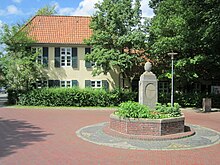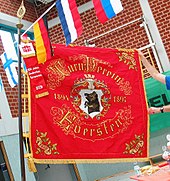Eversten
|
Eversten
City of Oldenburg
Coordinates: 53 ° 7 ′ 47 " N , 8 ° 10 ′ 49" E
|
||
|---|---|---|
| Height : | 4 m above sea level NHN | |
| Residents : | 24,650 | |
| Incorporation : | 1924 | |
| Postal code : | 26131 | |
| Area code : | 0441 | |
|
Location of Eversten in Lower Saxony |
||
Eversten is a district in the west of Oldenburg in Lower Saxony . It also includes the suburbs of Thomasburg and Bodenburg . The name is derived from the von Eversen family, which died out in the 16th century .
history
Eversten and the surrounding areas are located in the north-west of the Saxon Lerigau called Der Winkel and belonged to the parish Westerstede , today Westerburg (not to be confused with the eponymous Westerstede in the neighboring Ammergau ) until 1463 . The name Everse has been documented since the end of the 14th century and is derived from the knightly von Eversen family , who had their ancestral seat there since the 13th century and went out at the beginning of the 16th century. Previously, the area was called Nortwinkele , derived from the location of the region in the north of the "angle".
The swamp and moorland were first settled around 1200 by the von Eversen family, who established their ancestral home here. Otherwise, the area in front of Eversten Thor remained largely uninhabited until well into the 17th century - also due to a building ban by the Count of Oldenburg - and was mainly used for peat extraction . It was not until 1648 that the Bloherfeld watercourse was created, a ditch that allowed the peat bogs in front of the Wildenloh to be drained and thus settled. The first settlers began to develop the barren land around 1700. Most of the land usable for agricultural use was to the west of today's A 28 , so that the first “settlement core” was formed here, in which the first school was built in 1746.
Until the occupation of Oldenburg by Napoleonic troops in 1810, Eversten belonged to the Oldenburg bailiwick and then to the canton of Oldenburg in the department of the Weser estuaries . After the end of the occupation in 1814, the re-established Duchy of Oldenburg was divided into offices , and Eversten became part of the Oldenburg office as a village in the rural municipality of Oldenburg .
In 1833 Oldenburg expanded to the area of its neighbor for the first time: west of the Eversten Gate, the ducal palace garden was built from 1804 south of the road to Eversten , and over the years many stately officials and wealthy private individuals settled in villa-like houses in the area north of the road . Since they felt they belonged to Oldenburg and not to the rural community due to their social position, they achieved, with the support of the city's magistrate, that this area was annexed to the city of Oldenburg by decree of Grand Duke Paul Friedrich August .
In 1897 the rural community of Oldenburg was divided up along the Oldenburg – Wilhelmshaven railway line at the request of the wealthier population of the community order . The north-eastern part became the municipality of Ohmstede , and the south-western part became independent as the municipality of Eversten . It included alongside Eversten itself, the villages Bloh , Bloherfelde , Hundsmühlen , Metjendorf , oven , Ofenerfeld and Wehnen and peat Friedrichsfehn with the Wildenloh, Nordmoslesfehn and Petersfehn .
From 1911 the city of Oldenburg tried to expand further into Everster area. But she succeeded only in 1923 to move the community Eversten to a contract that had the incorporation of the entire municipal area to Oldenburg to the content of what the city with a blow to the size as the fourth largest German city after Berlin , Rostock and Frankfurt made had - a request that the Oldenburg state parliament rejected. In 1924, the state parliament then approved an amended version of the contract, which provided for the division of the Eversten community instead of complete incorporation and only the eastern, urban part with Eversten, Wechloy, Bloherfelde, Nordmoslesfehn and Alexandersfeld was to be incorporated into the city of Oldenburg. The western, more rural part, however, remained independent as the municipality of Ofen in the Oldenburg district.
Eversten Holz and Everstenmoor
Eversten Holz is an 18-hectare landscape park with a long history. At the end of the 18th century, Duke Friedrich August with forester Johann Peter Ahlers , then Peter Friedrich Ludwig and finally (from 1829) Grand Duke Paul Friedrich August with court garden inspector Julius Bosse had a special influence on the design. The Eversten wood is used today for local recreation. The state of Lower Saxony and the local palace garden administration are responsible. Since 2008 the Friends of Eversten Holz eV has been at her side
In the extreme southwest is the Everstenmoor . It is 105 hectares and has been a nature reserve since 1990. Walkers are allowed to enter the moor on marked paths.
Evangelical parish Eversten
The independent Evangelical Parish Eversten came into being on May 1, 1901, when the previous parish of Oldenburg with the parish church of St. Lamberti , which in addition to the city also included the entire previous rural community of Oldenburg, was transformed into four independent parishes as part of the redesign of the political map around the city of Oldenburg was divided. The political community Eversten was divided into two parishes. On the one hand the parish of Ofen , responsible for the parish order, on the other hand the parish of Eversten , responsible for the parish south , as well as for the localities Südmoslesfehn and Hundsmühlen of the parish Wardenburg . The new parish church of St. Ansgari was consecrated on December 4, 1902, until then the services were held in the Lamberti Church as before.
In 1969 Friedrichsfehn was separated from the Eversten parish and merged with Petersfehn, who had previously belonged to the Ofen parish, to form the Friedrichsfehn-Petersfehn parish . The remaining parish of Eversten was then divided into the four parishes of Bloherfelde , Eversten-Nord , Eversten-Mitte and Eversten-Süd on January 1st, 1970 , which in turn merged to form the Evangelical Lutheran Church Community Eversten . On June 1, 1994, the following parishes were formed from the parishes Bloherfelde , Eversten-Nord , Eversten-Mitte , Eversten-Süd : Ev.-luth. Parish Bloherfelde , Ev.-luth. Parish of St. Ansgar Eversten , Ev.-luth. Parish Nikolai Eversten .
In the meantime, the church border between Eversten and Wardenburg has also been aligned with the political border, and the villages of Hundsmühlen and Südmoslesfehn, which belong to the Oldenburg district and which previously belonged to the Oldenburg Stadt church district, have been connected to the Delmenhorst / Oldenburg-Land church district and have since formed their own with Tungeln Parish.
traffic
Eversten is connected to local public transport by the following bus lines operated by Verkehr und Wasser GmbH (VWG) :
- Line 301 : This line serves all the stops on Hauptstraße and follows the Edewechter Landstraße to Margarete-Gramberg-Straße. The buses go via Kaspersweg and Osterkampsweg to the final stop Eversten / Schramperei.
- Line 318 : This line serves the Eversten-West development area.
- Line 322 : This line serves the Thomasburg settlement area via the Bodenburgviertel and Hausbäker Weg.
- Line 324 : At Eversten cemetery, this line travels via Paulstraße and Ulhornsweg towards BBS Wechloy.
Everstens is connected to the trunk road network via the Oldenburg-Eversten exit of the A 28 , which crosses the district lengthways, and via the B 401 , which runs along the coastal canal in the south.
TuS Eversten
After the end of the Second World War , many expellees from eastern Germany found their new home in Eversten, and when building activity began in Oldenburg in the 1950s, Eversten was a particularly popular building area. This also results in the strong increase in members in Turn- und Sportfreunde Eversten ( TuS Eversten ) with around 1,800 members (as of the general assembly in March 2013).
At the founding meeting on January 30, 1894 in the Odeon on Wienstraße opposite the community fountain, 29 people present founded the Eversten gymnastics club. In the course of the evening the number of members rose to 42. The monthly fee was set at 50 pfennigs for members and 30 pfennigs for club friends and gymnastics students.
After the end of the Nazi era and the Second World War, the city administration of Oldenburg resumed civilian gymnastics and sports with the British military government. After the clearance on August 1, 1945, the "Sportkreis Oldenburg" was launched on December 17, 1945. An extraordinary general meeting of the gymnastics club Eversten took place on November 27, 1945. At the suggestion of honorary chairman Georg Harms, the club was given the new name “Turn- und Sportfreunde Eversten von 1894 e. V. ".
Eversten fountain course
The largest event in Eversten is the Eversten Fountain Run. The TuS Eversten running club has been organizing the eighth largest (NLVA 2011) fun run in Lower Saxony with around 3000 runners for 18 years. The fun run always takes place on the first Sunday in June. The Everstener Brunnenlauf is characterized by the fact that around 1,400 schoolchildren run for the class box prizes.
literature
- Georg Bredehorn: Eversten: From 1200 to the 20th century . Isensee-Verlag, Oldenburg 2001, ISBN 3-89598-750-6 .
- Chronicle: 100 years of gymnastics and sport in Eversten, publisher TuS Eversten, from the chapter gymnastics by Herbert Kayser, editing by Gerda Sluiter, Druck Hemmelter offset printing.
Web links
- Website of the Oldenburg-Eversten Citizens' Association
- Old pictures from Eversten on www.alt-oldenburg.de
- Gymnastics and sports enthusiasts Eversten
- Eversten fountain course
Individual evidence
- ↑ The Eversten Wood in Oldenburg . Master's project at Leibniz University Hannover , project supervisors Birte Stiers and Rainer Schomann, winter semester 2012/13. Hanover 2013.
- ↑ District Court of Oldenburg (Oldenburg) VR 200447.





